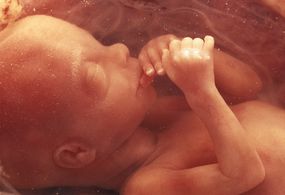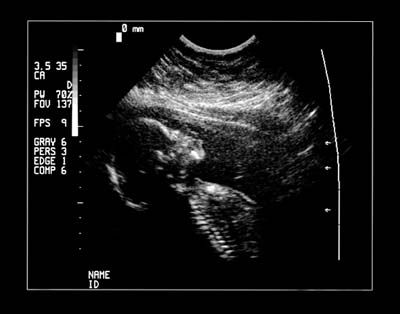
It might seem like fetuses aren't up to much other than growing in the cozy, warm environment that is the mother's womb. However, research published in the June 8, 2017 journal Current Biology showed that third-trimester babies have vision capabilities much more advanced than previously thought. And they can choose what they want to look at.
Researchers from Lancaster University in the United Kingdom were keen on expanding the understanding of fetal sight capabilities. "We have been able to explore the use of all the fetal senses except vision up until now," explained lead researcher and professor of psychology Vincent Reid in an email interview in 2017. "There is a lot that we know about newborn babies and their vision, but almost nothing with fetuses just before they are born. The newborn is very good at processing faces and prefers to look at faces over any other shape so it was logical to explore the development of this preference before birth."
Advertisement

A total of 39 fetuses were examined (there would have been more, but some of the babies were in deep sleep because they missed the memo about participating in a research study, while others experienced poor image quality). They ranged in gestational age from 231 to 252 days, and were all single births.
Obviously, since the fetal participants were still cooking in their moms' wombs, the researchers resorted to noninvasive attempts to assess their visual capabilities. To do so, the scientists shone a light through the maternal tissue. "The light consisted of three dots," Reid explained. "When these are arranged to represent two for the eyes and one for the mouth, newborn babies prefer to look at them more than anything else. So we didn't show fetuses a 'face' but an image that was 'face-like.'"
The researchers used 4-D ultrasound to measure if and how much the fetuses turned their heads in response to the stimuli. They also showed the same three-dot pattern, but inverted (so it didn't resemble a face in structure) to the fetuses. As it turns out, non-face-like dots were none too appealing. "Turning it upside down means that newborns do not find it interesting," Reid noted.
Although subtle, attraction to the face-like configuration of three dots makes a big difference in what we understand about developing sight. "It means that we have this preference even before we are born," Reid said. "[It] is either due to being innate or due to experiences prior to birth."
Another major finding of this research is that it moves up the human visual timeline. "We now know that the fetus actively engages with visual information in the [prenatal] environment," Reid said. "The head movement was a deliberate movement to track the stimuli that we presented. This means that we can now look at many other aspects of fetal vision."
Indeed, the study has laid the groundwork for future delving into fetal vision, because as it stands right now, little is known about how much fetuses can see. "Nobody has looked at this before," Reid said. "A week-old infant has very poor focal vision. It is all blurred. The same will be true for a fetus a few weeks before birth. We know that premature infants can see shapes, lights, and details. But that is once they are born, and it could be that the prenatal environment is different. We need to find out."
When we interviewed Reid he said his group next planned to investigate whether fetuses could discriminate between quantities or numbers, which he noted is something that even newborns can do. "If the fetus can do this too, this tells us a lot about fetal cognitive capacities," he said. "We're also keen to look at how the fetus sees motion. Babies prefer to look at animate or biological motion. If the fetus has this preference, this would suggest that experiences that they have had engaging with their own body may have given rise to these preferences."
Advertisement


